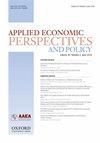美中农业贸易和环境后果:以流入墨西哥湾的养分径流为例
IF 3.4
2区 经济学
Q2 AGRICULTURAL ECONOMICS & POLICY
引用次数: 0
摘要
我们使用一个综合评估模型量化了流入墨西哥湾、美国农业生产和出口到中国的氮(N)之间的关系。我们表明,中国对美国大豆和玉米征收25%的关税,会使每年流入墨西哥湾的氮径流增加800公吨(0.2%),因为密西西比河流域的大豆生产被氮密集型作物所取代。研究结果还表明,流入墨西哥湾的氮径流减少10%,美国对中国的玉米出口减少14.5%,这与中国对玉米和大豆征收25%关税的效果相似。本文章由计算机程序翻译,如有差异,请以英文原文为准。
U.S.–China agricultural trade and environmental outcomes: The case of nutrient runoff to the Gulf of Mexico
We quantify the relationship between nitrogen (N) runoff to the Gulf of Mexico, U.S. agricultural production, and exports to China using an integrated assessment model. We show that a 25% Chinese tariff on U.S. soybean and corn increases annual N runoff to the Gulf by 800 metric tons (0.2%) as soybean production in the Mississippi River Basin is displaced with more N-intensive crops. Results also indicate that reducing N runoff to the Gulf by 10% decreases U.S. corn export to China by 14.5%, similar to the effect of a 25% Chinese tariff on corn and soybeans.
求助全文
通过发布文献求助,成功后即可免费获取论文全文。
去求助
来源期刊

Applied Economic Perspectives and Policy
AGRICULTURAL ECONOMICS & POLICY-
CiteScore
10.70
自引率
6.90%
发文量
117
审稿时长
>12 weeks
期刊介绍:
Applied Economic Perspectives and Policy provides a forum to address contemporary and emerging policy issues within an economic framework that informs the decision-making and policy-making community.
AEPP welcomes submissions related to the economics of public policy themes associated with agriculture; animal, plant, and human health; energy; environment; food and consumer behavior; international development; natural hazards; natural resources; population and migration; and regional and rural development.
 求助内容:
求助内容: 应助结果提醒方式:
应助结果提醒方式:


